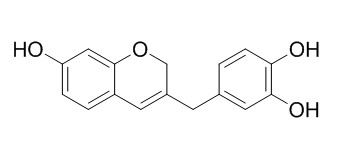7,3',4'-Trihydroxy-3-benzyl-2H-chromene
7,3',4'-Trihydroxy-3-benzyl-2H-chromene is a potential xanthine oxidase inhibitor.
Inquire / Order:
manager@chemfaces.com
Technical Inquiries:
service@chemfaces.com
Tel:
+86-27-84237783
Fax:
+86-27-84254680
Address:
1 Building, No. 83, CheCheng Rd., Wuhan Economic and Technological Development Zone, Wuhan, Hubei 430056, PRC
Providing storage is as stated on the product vial and the vial is kept tightly sealed, the product can be stored for up to
24 months(2-8C).
Wherever possible, you should prepare and use solutions on the same day. However, if you need to make up stock solutions in advance, we recommend that you store the solution as aliquots in tightly sealed vials at -20C. Generally, these will be useable for up to two weeks. Before use, and prior to opening the vial we recommend that you allow your product to equilibrate to room temperature for at least 1 hour.
Need more advice on solubility, usage and handling? Please email to: service@chemfaces.com
The packaging of the product may have turned upside down during transportation, resulting in the natural compounds adhering to the neck or cap of the vial. take the vial out of its packaging and gently shake to let the compounds fall to the bottom of the vial. for liquid products, centrifuge at 200-500 RPM to gather the liquid at the bottom of the vial. try to avoid loss or contamination during handling.
Cells.2024, 13(14):1229.
Phytomedicine.2019, 59:152785
Int J Mol Sci.2019, 20(9):E2244
Food Sci Biotechnol.2024, 33(15):3629-3637.
Phytomedicine.2019, 58:152893
Malaysian Journal of Analytical Sciences2022, 26(2):360-369.
Nutrients.2024, 16(15):2518.
Cytotechnology2022, s10616
Asian Pac J Cancer Prev.2019, 20(1):65-72
Biomedicine & Pharmacotherapy2020, 125:109950
Related and Featured Products
Chinese Journal of Pharmaceutical Analysis,2014,34(8):1391 -6.
In vitro screening of potential xanthine oxidase inhibitors by high-performance liquid chromatography[Reference:
WebLink]
To develop an HPLC method for In vitro screening of xanthine oxidase inhibitors.
METHODS AND RESULTS:
The activity of xanthine oxidase inhibitors was evaluated by the concentration of xanthine assayed by HPLC. The chromatographic conditions were as follows:column, Agilent SB-C18 (4.6 mm×250 mm, 5 μm); mobile phase, 0.02 mol·L-1 KH2PO4 (1% methanol); flow rate, 1.0 mL·min-1; detection wavelength, 254 nm; injection volume, 20 μL; column temperature, room temperature. Xanthine was perfectly separated from the other components under the selected chromatographic conditions. The xanthine oxidase inhibitory activity of 14 traditional Chinese medicines was evaluated by the above method. The 70% ethanol extracts of Quisqualis indica,Caesalpinia sappan,Polygonum cuspidatum and Paeonia suffruticosa showed significant activity with IC50 of 10. 04,8. 02,2. 06 and 1. 36 mg·mL- 1,respectively. Then,24 compounds isolated from C. sappan were evaluated by the above method. 7,3',4'-Trihydroxy-3-benzyl-2H-chromene,3-deoxysappanone B,sappanchalcone and protosappanin A showed xanthine oxidase inhibitory activity.
CONCLUSIONS:
This HPLC method is simple,accurate and suitable for in vitro screening of xanthine oxidase inhibitors.
J Nat Med. 2008 Jul;62(3):325-7.
A new homoisoflavan from Caesalpinia sappan.[Pubmed:
18404306]
METHODS AND RESULTS:
A new homoisoflavan, 7,3',4'-Trihydroxy-3-benzyl-2H-chromene (1), was isolated from the dried heartwood of Caesalpinia sappan L., together with seven known phenolic compounds. The structure of the new compound (1) was determined on the basis of spectroscopic analysis.



